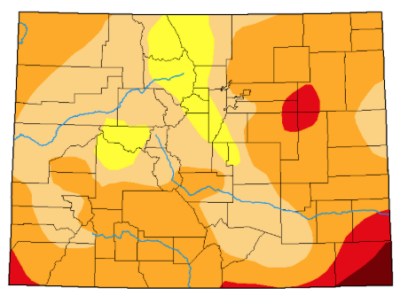As the brittle landscape in Colorado screams for rain amid a two-decade drought, water watchers have been looking at the high peaks and wondering what this year’s runoff will amount to, and how much of that will sink into the parched soil enroute to its intended waterway.
Last year the players in the local rafting industry said there was reason to be nervous looking ahead to 2022 if the drought in the West persisted.
As the Bureau of Reclamation made its historic shortage declaration on the Colorado River Aug. 16, the internationally known waters through Browns Canyon National Monument invited a question: Would the supplemental water releases from the Fry-Ark network continue to plump those waves – and the economy tied to them – between July 1 and Aug. 15, 2022?

The U.S. Drought Monitor for May 12 shows a drying landscape across much of the state. Image/US Drought Monitor
It appears that is the case for another season. According to Greg Felt, a Chaffee County Commissioner who sits on numerous water boards throughout the state (including a governor’s appointment to the Colorado Water Conservation Board), the Voluntary Flow Management Program (VFMP) will once again deliver 10,000 acre-feet into the Arkansas.
In addition, he says, the Pueblo Board of Water Works plans to send roughly 5,000 acre-feet into the river, and that doesn’t necessarily need to coincide with the VFMP.
Fry-Ark, or Fryingpan-Arkansas, is the trans-basin diversion system that flows out of the Fryingpan River in Pitkin County and is released from Twin Lakes and Turquoise Lake. Its origins are on the increasingly stressed Colorado River. All told, Fry-Ark sends out an average 58,000 acre-feet annually, much of it used in agriculture below the Pueblo Reservoir.
Last year, the drought saw a break with rains on the Front Range as well as rain in and around Chaffee County that hinted at a monsoon pattern. “Don’t discount rain,” says Felt. “It does a tremendous amount for agriculture and we saw that last year.”
That said, he noted that “there’s a pretty big question mark in what to expect this year in snowpack and streamflow.”
Local irrigation ditches are in line to be called into priority and many are already running. Those who run ditches with junior rights continue to look at the drying peaks and the water calls, hoping there is enough runoff for this season.
Currently, the U.S. Drought Monitor isn’t reporting much good news. Comparing Colorado maps on April 12 and May 10, much of the state has moved from moderate to severe drought, with Chaffee County remaining in a mostly moderate drought, with swaths of severe in the south and southeast edges. As well, the state continues to have pockets of extreme and exceptional drought, with a new patch of extreme drought that has moved onto the corners of Washington, Lincoln, Adams, Arapahoe and Elbert counties.
Featured image: The Arkansas River is an economic driver of the entire Arkansas River Valley. Photo by Tara Flanagan.







Recent Comments